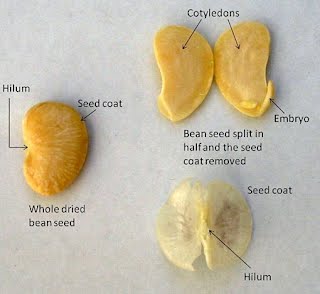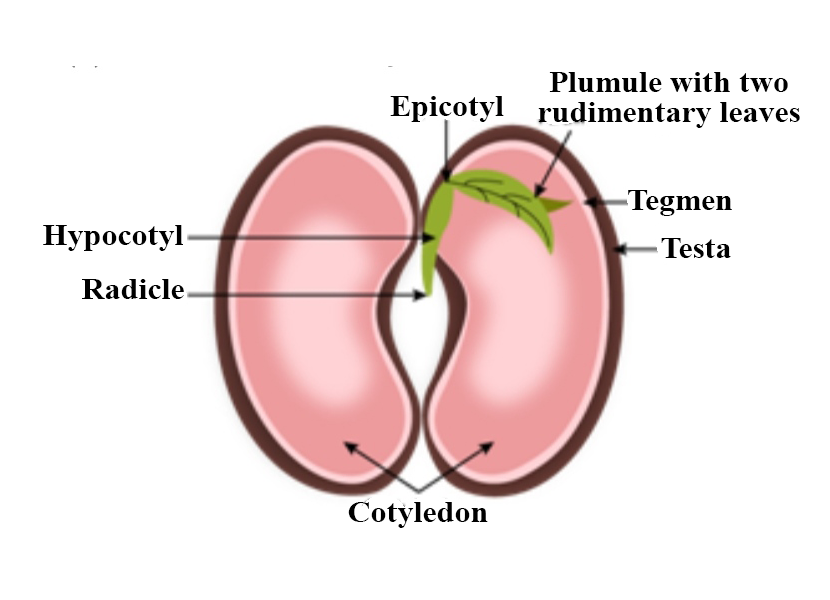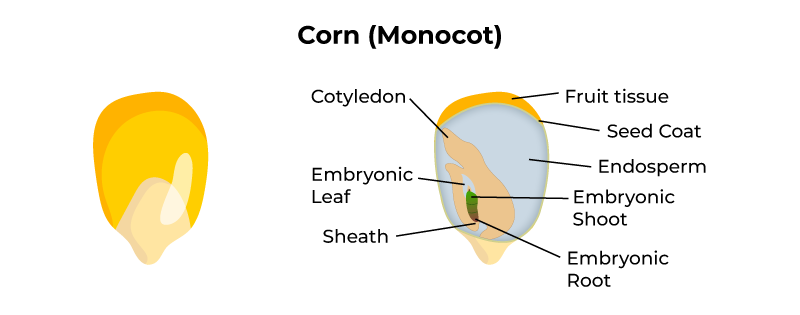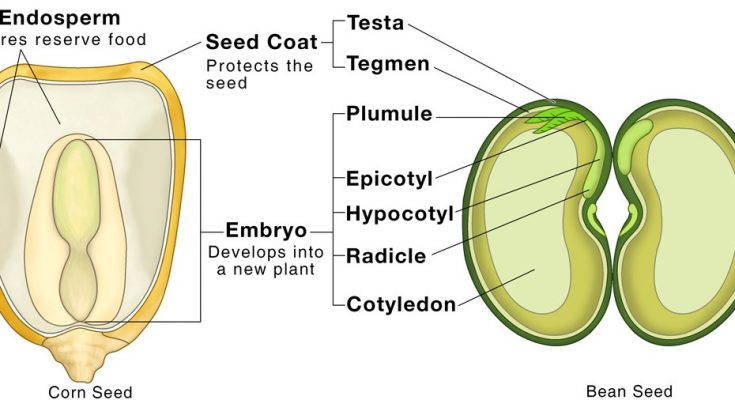What is a Seed?
Seed can be defined as a mature ovule after fertilization which contains a tiny living plant, the embryo (developed from the fused sperm nucleus and the egg nucleus).
- The embryo consists of a radicle (future root), plumule (future shoot) and cotyledons or seed
- leaves (future leaves). The embryo remains in an inactive (dormant) state, but upon exposure to favorable conditions it germinates.
- The seed may also contain endosperm which is the food material for the nourishment of the embryo during germination.
- The seed can withstand unfavorable conditions of temperature, drought, etc. Some seeds are known to remain dormant even up to 100 years or more.
Structure of the Seed
- Seeds vary in size Some are so small that they are barely visible to the naked eye; e.g. poppy seeds, strawberry seeds.
- Some are quite large as in mango, plum, etc. Largest seeds are those of coconut and double coconut.
- The size, shape and structure of seeds of different plants vary considerably but the basic structure of most seeds is the same.
Types of Seeds
On the basis of endosperm, seeds are classified as:
- Endospermic
- Non-Endospermic
Endospermic seeds
In Endospermic seeds, cotyledons are thin and membranous and endosperm persists; e.g. apple.
Non-Endospermic seeds
In Non-Endospermic seeds, the cotyledon stores food and becomes thick and fleshy; e.g. Monocot Non-Endospermic seeds -Vallisneria, orchids. Dicot Non-Endospermic seeds – Gram, pea, mango, mustard.
The seeds are Broadly classified into two kinds
- Monocotyledon
- Dicotyledon
Monocotyledon
- Monocotyledonous seeds contain one cotyledon (seed leaf); e.g. maize, grasses.
Dicotyledon
- Dicotyledonous seeds contain two cotyledons; e.g. pea, gram, bean.
The Dicotyledon Seed Structure- The Bean Seed
There are a number of different kinds of beans such as broad bean, lima bean, french bean, etc., but the general structure of their seeds is the same.
Most are kidney-shaped with a convex and a concave side.

Parts of Bean seed
- Seed coat consists of testa, the outermost hard brownish covering. It protects the delicate inner parts of the seed from injury and from the attack of bacteria, fungi and insects.
- Tegmen is a thin inner layer lying next to the testa, and is also protective in nature.
- Hilum is a distinct whitish oval scar on the concave side of the seed.
- It represents the spot where the ovule (now the seed) was attached to the ovary wall through placenta.
- A tiny pore called micropyle is situated close to the hilum. It marks the opening through which the pollen tube has entered the ovule.
Micropyle serves two functions :-
- When soaked in water, the seeds absorb water mainly through this micropyle and make it available to the embryo for germination.
- It provides for the diffusion of respiratory gasses for the growing embryo.

- Below the seed coat are two thick cotyledons which contain food for the embryo and protect it.
- On carefully separating the two cotyledons, the tiny embryo can easily be seen attached to one of the cotyledons.
- The embryo consists of two parts- the radicle which later forms the root and the plumule which later forms the shoot.
- The plumule consists of a short stem with a pair of tiny leaves and a growing point between them.
- The region of the axis between the point of attachment of cotyledons and the plumule is called epicotyl.
- The region of the axis below the cotyledons is called hypocotyl.
Also Check – 9 Key Differences Between Radicle and Plumule
The Monocotyledon Seed Structure- The MAIZE GRAIN

- The maize grain is actually a single-seeded fruit in which the fruit wall and the seed coat are fused together to form a protective layer. Therefore, we call such a fruit as grain.
- On one side of the grain occurs a small light- coloured oval area which marks the location of the embryo inside.
- The remaining major part of the grain contains a large endosperm which is rich in starch.
- The endosperm and the embryonic part are separated from each other by a thin epithelial layer.
- The outermost layer of the endosperm is rich in protein and is called the aleurone layer.
- The embryo consists of a single cotyledon here called scutellum, a radicle and a plumule.
- The radicle is towards the pointed end and it is enclosed in a protective sheath, the coleorhiza. The plumule is towards the upper broader side of the embryonic region and is enclosed in a protective sheath, the coleoptile.
- The maize grain is monocotyledonous and endospermic. Some other examples of this type of grains are rice, wheat and oat.

